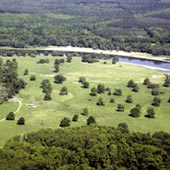

Cultural Landscape
The Dessau-Wörlitz Garden Realm is a combination of sculpted landscape, art, education and economy that is unique in Germany.
Embedded in the meadows of Mulde and Elbe, now part of the Biosphere Reserve Landscape Middle Elbe, a spectacular, cultural landscape was created in the second half of the 18th century. Castles, gardens and individual buildings are connected with each other by view cuts, roads, alleys and cultivated dyke systems, meadows with solitary oak trees and orchards. Since November 2000, the Garden Realm has been a UNESCO World Heritage Site.

History: The Dessau-Wörlitz Reform Work
The spirit of emerging enlightenment fundamentally changes life in Anhalt-Dessau in the second half of the 18th century. In agriculture, new methods swell harvests and the social conditions for the population improve. Prince Leopold III Friedrich Franz von Anhalt-Dessau (1740 to 1817), a ruler with humanist tendencies, puts his vision into practice:
he transforms the entire state into a garden.
700 km², approximately the entire surface space in the principality, are artistically sculpted and gentrified from 1760 until the Prince’s death in 1817. The principle of landscape gardening and Neo-Gothic styles are imported from England and aligned to suit the monarch’s ambitions. At his side, the architect Friedrich Wilhelm von Erdmannsdorff (1736 to 1800) designs buildings, temples and complexes. With this work, he invents continental classicism – two generations before Schinkel.
The Prince employs an army of gardeners, dyke builders, foresters and agriculturalists. Step for step, his vision gradually becomes tangible. A world is created in which everything is targeted at combining beauty, the aesthetic effect, the useful and the educative programme: the historical Garden Realm.

History: Sculpted Worlds: Complexes
In 1797, Carl August Boettiger describes his impressions of the Garden Realm. He uses the metaphor "temple of nature ". The artistically underscored, aesthetic effects of nature and the atmospheric impressions of its seasons create a breath-taking scenery in the Garden Realm, highlighted by the castles, parks and gardens. They are spread throughout the landscape like a chain. Their characteristic feature: the grounds pass over into the open landscape without boundaries.
Many of the buildings, monuments and often times mythological sculptures constructed in the Garden Realm are often intended for moral education. The buildings suit their environs. Belts of paths through the park complexes permit glances through the gardens and the open landscape. A network of view cuts ensures that one’s glance is captured by objects within the garden architecture and then passed on.
Oak and fruit trees have a significant role in the Garden Realm. Meadows, with mighty, old solitary oak trees became a part of the landscape composition. Targeted cultivation created meadows with solitary oak trees. Within the Garden Realm, they characterise the transition from open meadows to forests.
Meadow orchards were created as an additional element and then in some cases leased by Prince Franz. This generated the stately sum of one thirteenth of the state income. The fruit trees were arranged in a pattern for reasons of fouling and maturity. This meant that sweet and sour cherries were mainly found close to the villages.



